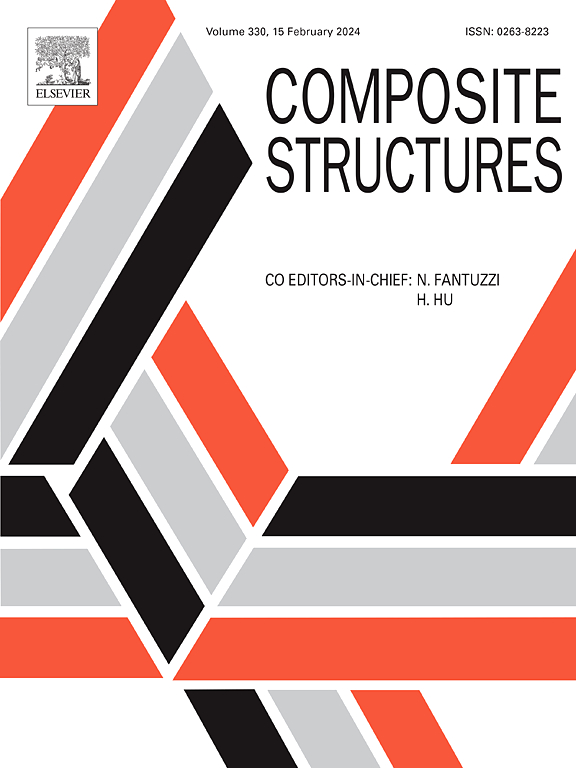FRCM confinement of concrete columns: a review of strength and ductility enhancements
IF 6.3
2区 材料科学
Q1 MATERIALS SCIENCE, COMPOSITES
引用次数: 0
Abstract
Fiber reinforced cementitious matrix (FRCM) systems have recently emerged as a promising method for strengthening concrete columns, offering notable gains in strength and ductility due to their mechanical performance and compatibility with concrete substrates. This paper presents a comprehensive review of the behavior of concrete compression elements confined with FRCM systems, based on data from 66 experimental studies – 36 on plain concrete (PC) and 30 on reinforced concrete (RC) columns – covering over 1036 PC and 294 RC tests.
Specimens were categorized by slenderness, loading conditions, cross-sectional shape, concrete type, FRCM configuration, and reinforcement ratio. The analysis highlights the improved capacity and ductility of FRCM-confined columns under various conditions, including seismic and fire exposure. Among the fabrics studied, polyphenylene benzobisoxazole (PBO) fabric showed superior bonding and performance, while FRCM systems incorporating modified high-strength matrices delivered outstanding strength and deformation capacity. Key parameters such as concrete compressive strength, number of FRCM layers, cross-sectional geometry, and mortar properties were found to significantly influence confinement effectiveness. Columns with higher concrete strength or noncircular sections exhibited reduced benefits, while smaller or lower-strength columns demonstrated greater improvements. In addition, the review critically examines existing design methods and predictive equations for FRCM-confined columns. Finally, directions for future research are outlined, emphasizing key parameters that require further investigation to enhance the reliability and efficiency of FRCM systems in structural strengthening applications
混凝土柱的FRCM约束:强度和延性增强的回顾
纤维增强胶凝基质(FRCM)系统最近成为一种很有前途的混凝土柱加固方法,由于其机械性能和与混凝土基体的相容性,其强度和延性显著提高。本文基于66项试验研究(36项素混凝土(PC)试验和30项钢筋混凝土(RC)柱试验)的数据,对受FRCM系统约束的混凝土压缩元件的行为进行了全面回顾,涵盖了1036项混凝土和294项钢筋混凝土试验。试件按长细比、加载条件、截面形状、混凝土类型、FRCM配置和配筋率进行分类。分析强调了在各种条件下,包括地震和火灾暴露下,frp约束柱的能力和延性的提高。在所研究的织物中,聚苯二苯并异恶唑(PBO)织物表现出优异的粘合和性能,而含有改性高强度基质的FRCM系统则具有出色的强度和变形能力。混凝土抗压强度、FRCM层数、截面几何形状和砂浆性能等关键参数对约束效果有显著影响。具有较高混凝土强度或非圆形截面的柱表现出降低的效益,而较小或较低强度的柱表现出更大的改善。此外,审查严格审查现有的设计方法和预测方程的钢筋混凝土约束柱。最后,对未来的研究方向进行了概述,强调了需要进一步研究的关键参数,以提高FRCM体系在结构加固应用中的可靠性和效率
本文章由计算机程序翻译,如有差异,请以英文原文为准。
求助全文
约1分钟内获得全文
求助全文
来源期刊

Composite Structures
工程技术-材料科学:复合
CiteScore
12.00
自引率
12.70%
发文量
1246
审稿时长
78 days
期刊介绍:
The past few decades have seen outstanding advances in the use of composite materials in structural applications. There can be little doubt that, within engineering circles, composites have revolutionised traditional design concepts and made possible an unparalleled range of new and exciting possibilities as viable materials for construction. Composite Structures, an International Journal, disseminates knowledge between users, manufacturers, designers and researchers involved in structures or structural components manufactured using composite materials.
The journal publishes papers which contribute to knowledge in the use of composite materials in engineering structures. Papers deal with design, research and development studies, experimental investigations, theoretical analysis and fabrication techniques relevant to the application of composites in load-bearing components for assemblies, ranging from individual components such as plates and shells to complete composite structures.
 求助内容:
求助内容: 应助结果提醒方式:
应助结果提醒方式:


